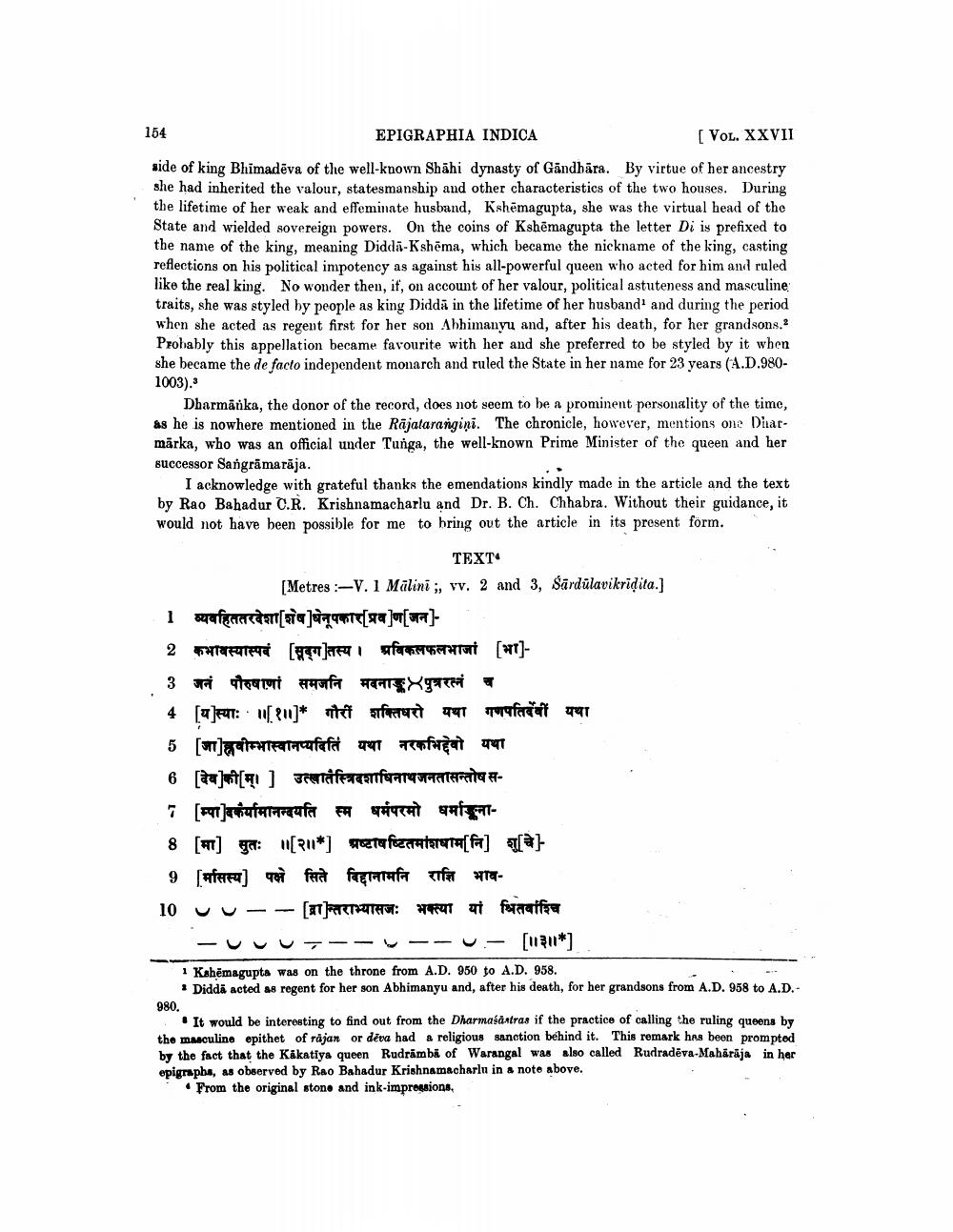________________
154
EPIGRAPHIA INDICA
[VOL. XXVII
side of king Bhimadēva of the well-known Shāhi dynasty of Gāndhāra. By virtue of her ancestry she had inherited the valour, statesmanship and other characteristics of the two houses. During the lifetime of her weak and effeminate husband, Kshēmagupta, she was the virtual head of the State and wielded sovereign powers. On the coins of Kshēmagupta the letter Di is prefixed to the name of the king, meaning Diddi-Kshēma, which became the nickname of the king, casting reflections on his political impotency as against his all-powerful queen who acted for him and ruled like the real king. No wonder then, if, on account of her valour, political astuteness and masculine traits, she was styled by people as king Diddă in the lifetime of her husband and during the period when she acted as regent first for her son Abhimanyu and, after his death, for her grandsons. Probably this appellation became favourite with her and she preferred to be styled by it when she became the de facto independent monarch and ruled the State in her name for 23 years (A.D.9801003).
Dharmárka, the donor of the record, does not seem to be a prominent personality of the time, as he is nowhere mentioned in the Rājatarangiņi. The chronicle, however, mentions one Diarmärka, who was an official under Tunga, the well-known Prime Minister of the queen and her successor Sangramarāja.
I acknowledge with grateful thanks the emendations kindly made in the article and the text by Rao Bahadur O.R. Krishnamacharlu and Dr. B. Ch. Chhabra. Without their guidance, it would not have been possible for me to bring out the article in its present form.
TEXT [Metres :-V. 1 Mölini ;, vv. 2 and 3, Sārdülavikridita.] I sparfistered at [star tante[ra]"[or] 2 ferretera ( dari afure aurat [1]3 जनं पौरुषाणां समजनि मदनाङ्करपुत्ररत्नं च 4 []RIT: 811]* mht sfere 41 ore farveft 1 5 [जाह्नवीम्भास्वानप्यदितिं यथा नरकभिद्देवो यथा 6 [a][1 ] sewidfa afargarantera - 7 [-]matatapaafar FH HECH T 8 [F] ga: [R11*] reta femratarata[fa] }
9 [मासस्य] पक्षे सिते विद्दानामनि राज्ञि भाव10 UU - -[07]
R UTHA: HRT o ferataifa -UUU - - - - U- [1120*] 1 Kahēmagupta was on the throne from A.D. 950 to A.D. 958.
• Didda acted as regent for her son Abhimanyu and, after his death, for her grandsons from A.D. 958 to A.D.980.
It would be interesting to find out from the Dharmasastras if the practice of calling the ruling queens by the masculino epithet of rajan or dēva had a religious sanction behind it. This remark has been prompted by the fact that the Kakatiya queen Rudrambi of Warangal was also called Rudradeva-Maharaja in her epigraphe, as observed by Rao Bahadur Krishnamacharlu in a note above.
• From the original stone and ink-impressions,




